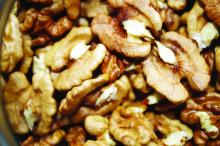Heart failure (HF) patients with high serum levels of alpha-linolenic acid (ALA) had a better prognosis than those with the lowest levels, in an observational study.
ALA is an omega-3 fatty acid that is found mainly in plants, including flaxseed, chia, walnuts, or canola oil.
“The most striking finding to us is the clear difference between patients at the bottom quartile compared to the other 75%, pointing to a threshold on the putative effect of ALA, reinforcing the notion that ‘one size does not fill all,’ ” Aleix Sala-Vila, PharmD, PhD, of the Hospital del Mar Medical Research Institute, Barcelona, told this news organization.The analysis, which was published online in the Journal of the American College of Cardiology, showed statistically significant reductions in all-cause death, cardiovascular (CV) death, and first HF hospitalization among those in the three upper quartiles of serum ALA levels, compared with those in the lowest quartile.
The team’s earlier finding that higher levels of serum phosphatidylcholine eicosapentaenoic acid (PC EPA) and ALA were associated with a lower risk of adverse events in patients with ST-segment elevation myocardial infarction prompted the current study, Dr. Sala-Vila said.
Although their findings are hypothesis-generating at this point, he added, “inclusion of some ALA-rich foods, such as walnuts, in the diet of any individual, whether they have HF or not, might translate into CV benefits, besides the putative effect on HF. There is no evidence of any deleterious effect of one daily serving of walnuts, not even on weight gain.”
Plant power
Dr. Sala-Vila and colleagues analyzed data and samples from 905 patients (mean age, 67; 32% women) with HF of different etiologies. ALA was assessed by gas chromatography in serum phospholipids, which reflect long-term dietary ALA intake and metabolism.
The primary outcome was a composite of all-cause death or first HF hospitalization. The secondary outcome was the composite of CV death or HF hospitalization.
After a median follow-up of 2.4 years, 140 all-cause deaths, 85 CV deaths, and 141 first HF hospitalizations occurred (composite of all-cause death and first HF hospitalization, 238; composite of CV death and HF hospitalization, 184).
Compared with patients at the lowest quartile of ALA in serum phospholipids, those at the three upper quartiles showed a 39% reduction in the risk of the primary endpoint (hazard ratio, 0.61).
Statistically significant reductions also were observed for all-cause death (HR, 0.58), CV death (HR, 0.51), first HF hospitalization (HR, 0.58), and the composite of CV death and HF hospitalization (HR, 0.58).
By contrast, nonstatistically significant associations were seen for fish-derived EPA, DHA, and the sum of EPA + DHA.
Limitations of the study include its observational nature; a relatively young cohort with reduced or mid-range ejection fraction and stage 2 chronic kidney disease; and no dietary data except for those regarding fatty acids.
“Controversial results from landmark recent trials on omega-3 might have translated into confusion/negative impact on the reputation of these fatty acids,” Dr. Sala-Vila noted. “Many factors affect how each participant responds to a certain intervention (precision nutrition), such as genetics, the microbiome, and the environment. In this regard, nutritional status – omega-3 background – is emerging as a key determinant.”

